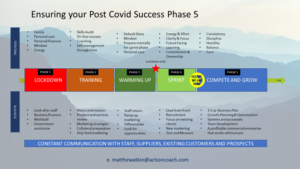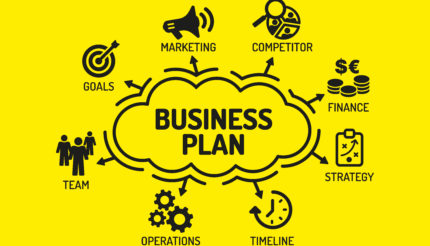This is the final article of five, designed to stimulate your thinking about how your business will develop and exploit the opportunities that will arise once lockdown is fully unwound. If any of this, or the other articles, have pricked your interest, do please book on a call with me to discuss how this might affect and benefit you and your business.

Your Business.
Business Planning:
All the preparation you have done thus far should be drawn together into a single document that is the distillate of your thinking. It should contain what the key success factors are, the marketplace in which you will compete, your Marketing, Sales, Operations, Management and Financial plans, including a well thought through conventional SWOT analysis. Why bother with what looks like a lot of work? Because I have yet to find a better way to enable the millions of thoughts that swirl around our heads to coalesce into a workable action plan than to write them down in a reasoned and ordered way. During the process you will test ideas, rejecting some, developing others, all the while converting them into actionable tasks with measurable outcomes.
In a fast-moving environment, a short-term plan may be the most suitable because things will have changed so much by the end of the period as to have rendered further planning irrelevant. On the other hand, a more stable situation may enable a longer-term view, sometimes necessary to understand the impact of significant changes and levels of investment.
Growth Planning & Optimisation:
As I mentioned yesterday there are only four ways to grow your business: generate more Leads, Convert more leads into customers, Transact more frequently with your customers and sell at a Higher Value. Which of these is possible depends on the market conditions and your product or service, but you must pick the ones that you have the best chance of influencing first. Usually the first I address is the conversion rate; how good is your sales process and have you reviewed it in light of the new business environment? Second, transaction frequency, because much can be done with your existing customers to encourage them to buy more, through enhanced value add or knowing your full product range. The hardest, most uncertain and most expensive is generating new qualified Leads. Yet this is often where people start.
It is essential that you test, measure and monitor your results, because only by knowing what is working and what generates a genuine return on investment can you begin to allocate the right level of funding to stimulate the right level of sales to optimize your production or service offer.
Systems and Processes:
Most businesses will have between 4-8 core processes which run the business. Note: your systems should run the business and your people should run the systems. This is a good time to check all your systems, update the systems manual (which might be written, video or audio) and ensure your team are fully trained to operate those systems. Finding the holes now before getting fully up to speed will save much heartache later.
Team Development:
One of the core systems mentioned above will be about your People and their Education, with good reason. At best you will only ever tread water without a motivated, educated, autonomous team. There are six keys to a brilliant team and I mentioned Strong Leadership yesterday. Two others are having a common Goal and a common Ethos. There are whole shelves of books written on this subject so I can do little more than this reference here, but I’d be delighted to discuss it further.
A Business that Works without You:
This may not be today’s concern for you, but almost none of us want to die whilst still in harness. However, a business that works without us gives us choice. We can expand what we’re already doing (e.g. opening additional offices), diversify into synergistic products or services (which will take our focus away from the existing business), install a general manager and become the Chairperson thereby looking after the interests of the shareholders, or we can sell the business. The buyer won’t want to buy us; they want to buy a consistent profit stream, so knowing the business will work without you makes it considerably more valuable to an investor or buyer.
Your objective must therefore be to become totally dispensable; you then have the freedom to choose what you do and how.
You and Your People.
Consistency:
Jim Collins (Good to Great) refers to Consistency with the analogy of ‘The Twenty Mile March’. The difference between Scott and Amundsen in their quest to be the first to reach the South Pole was that Amundsen set himself and his team the task of marching twenty miles towards their objective, every single day, regardless of the weather. Scott, on the other hand, marched in good weather and camped in bad. This had the same effect as the Hare and the Tortoise; Amundsen, the steady plodding tortoise, got to his objective first whilst Scott failed to do so and lost all his men in the process. What is your daily task – your 20-mile march – that will ensure you succeed, and what is the task that each of your team must complete daily? This really is worth some thought.
Discipline:
I have never met a successful businessman who was not highly self-disciplined. This means turning up to training in the dark and sleet; it means doing the stuff you know you should, even though you don’t want to; it means setting an example of which you’ll be proud. Remember, the sincerest form of flattery is imitation and your team will imitate, consciously or otherwise, if your discipline is exemplary.
Humility:
One of the world’s richest self-made men, Warren Buffett, still lives in the same house he has for almost all his adult life and eats burgers and coke whenever given the option. He appears unaware of his own ego and never lets it interfere with his rigorous investment approach. Humility is one of the key characteristics of many highly successful businessmen. The business and the team come first.
Balance:
Wherein lies the right balance between work and the rest of life? That is infinitely variable depending on the person, but the moment it falls out of balance, life becomes miserable, stressed, depressing. Evaluate with care your other priorities and ensure that you’re disciplined enough that you’re working to live and not living to work.
Fun:
We all need it, both at home and at work. If you doubt the latter, one stat might make you reconsider; productivity is enhanced by as much as 20% when your team feel that their working environment is fun. After all, this is not a dress rehearsal, so we’d better enjoy it!
To discuss anything I’ve said in any of these articles, use the contact button below and we’ll arrange a call.
CONTACT ME




